INTRODUCTION: HANDBALL RULES
Handball rules are not the easiest to understand and learn, thinking about it, we from DEF, made a big effort to summarize the main official handball rules in order to facilitate the study and understanding of all official handball rules.
RULE 01: PLAYING COURT SIZE
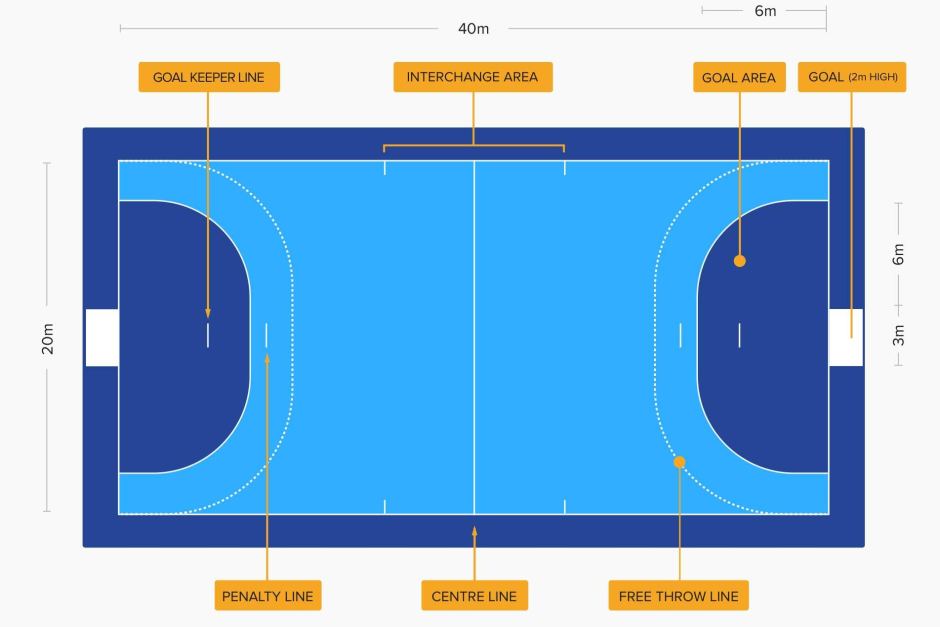
The Handball Court is a rectangle that measures 20 meters wide by 40 meters long. Handball court lines and markings are: goal areas, free-throw lines, goalkeeper’s restraining lines, 7-meter lines, substitution lines, center line, sidelines and the goal lines.
RULE 02: PLAYING TIME
According to official Handball rules, the normal playing time for all teams with players of age 16 and above is 2 halves of 30 minutes. The half-time break is normally 10 minutes.
- The normal playing time for youth teams is 2 x 25 minutes in age group 12-16;
- The normal playing time for youth teams is 2 x 20 minutes in age group 8-12;
- When the game is tied at the end of the regular playing time and a winner has to be determined, the overtime is played. Its period consists of 2 halves of 5 minutes, with a 1-minute half-time break.
RULE 03: THE HANDBALL BALL
The ball sizes, the circumference and weight, to be used by different categories of teams are as follows:
- Size 3: 58-60cm and 425-475g for Men and for Male Youth (over age 16);
- Size 2: 54-56cm and 325-375g for Women, Female Youth (over age 14), and Male Youth (age 12 to 16);
-
Size 1: 50-52cm and 290-330g for Female Youth (age 8 to 14) and Male Youth (age 8 to 12).y
RULE 04: THE HANDBALL TEAM
A team consists of up to 14 players. No more than 7 players may be present on the court at the same time. The remaining players are substitutes: A team must have at least 5 players on the court at the start of the game
RULE 05: THE HANDBALL SUBSTITUTIONS
According to the rules, substitutions are free, once they are made in the substitution zone and the substitute player only enters the court after the player in the field leaves the court.
RULE 06: THE HANDBALL GOALKEEPER
The Goalkeeper is allowed to:
- Touch the ball with any part of his body while in the act of defense inside the goal area;
- Move with the ball inside the goal area;
- Leave the goal area without the ball and participate in the game in the playing area.
The goalkeeper is not allowed to:
- Endanger the opponent while in the act of defense;
- Leave the goal area with the ball under control;
- Touch the ball when it is stationary or rolling on the floor outside the goal area, while he is inside the goal area;
- Re-enter the goal area from the playing area with the ball;
- Touch the ball with the foot or the leg below the knee, when it is moving out towards the playing area;
- Cross the goalkeeper’s restraining line (4-metre line) or its projection on either side, before the ball has left the hand of the opponent who is executing a 7-metre throw.
RULE 07: THE HANDBALL GOAL AREA
The Goal Area is restricted to the goalkeepers. When a regular player enters the goal area, the following sanctions should be taken:
- Goalkeeper throw when a player of the attacking team enters the goal area in possession of the ball or enters without the ball but gains an advantage by doing so;
- Free throw when a court player of the defending team enters the goal area and gains an advantage;
- 7-metre throw when a court player of the defending team enters the goal area and because of this destroys a clear chance of scoring.
“It is not allowed to pass the ball back to the goalkeeper while he is within his goal area. Free throw will be awarded to opposing team”
RULE 08: PLAYING THE BALL
- Throw, catch, stop, push or hit the ball, by using hands (open or closed), arms, head, torso, thighs, and knees;
- Hold the ball for a maximum of 3 seconds;
- Take a maximum of 3 steps with the ball;
- Bounce the ball once and catch it again with one or both hands;
- Bounce the ball repeatedly with one hand (dribble), and then catch it or pick it up again with one or both hands;
- Roll the ball on the floor repeatedly with one hand, and then catch it or pick it up again with one or both hands.
“Is not allowed to touch the ball with a foot or leg below the knee, except when the ball has been thrown at the player by an opponent.”
RULE 09:HANDBALL PASSIVE PLAY
Passive play is not allowed and it consist to keep the ball in the team’s possession without making any recognizable attempt to attack or to shoot on goal. Similarly, it is not allowed to delay repeatedly the execution of a throw-off, free throw, throw-in, or goalkeeper throw for one’s own team.
RULE 10: FOULS
It is not considering a foul when a player:
- Uses an open hand to play the ball out of the hand of another player;
- Uses bent arms to make body contact with an opponent, and to monitor and follow him in this way;
-
Uses one’s trunk to block the opponent, in a struggle for positions.
It is considering a foul when a player:
- Pulls or hits the ball out of the hands of the opponent;
- Blocks the opponent with arms, hand, legs, or to use any part of the body to displace him or push him away;
- Holds an opponent (body or uniform), even if he remains free to continue the play;
- Runs into or jumps into an opponent.
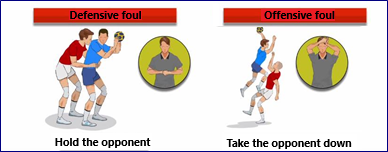
Fouls That Warrant an Immediate 2-Minute Suspension
- Fouls that are committed with high intensity or against an opponent who is running fast;
- Holding on to the opponent for a long time, or pulling him down;
- Fouls against the head, throat or neck;
- Hard hitting against the torso or throwing arm;
- Attempting to make the opponent lose body control;
- Running or jumping with great speed into an opponent.
- Protests, involving shouting with forceful gestures or provocative behavior;
- When there is a decision against the team in possession and the player in possession of the ball does not immediately make it available to the opponent by releasing it or leaving it on the ground;
- Block access to the ball that went into the substitution area.
RULE 11: NADBALL SCORING
A goal is scored when the entire ball has completely crossed the goal line.
RULE 12: THE HANDBALL THROW-OFF
- The Throw-off is taken at the start of the first (coin toss decision) and second half of play and after a goal has been scored;
- In case of an overtime, a new coin toss will be made;
- The throw-off is taken in any direction from the center of the court, it is preceded by a whistle signal, following which it must be taken within 3 seconds;
- The player taking the throw-off must take up a position with at least one foot on the center line, and the other foot on or behind the line;
- However, for the throw-off after a goal has been scored, the opponents of the thrower are allowed to be in both halves of the court, at least 3 meters away from the player taking the throw-of.
RULE 13: HANDBALL THROW-IN
- A throw-in is awarded when the ball has completely crossed the sideline;
- The throw-in is taken without whistle signal from the referees;
- The thrower must stand with a foot on the sideline;
- While the throw-in is being taken, the opponents may not be closer than 3 meters to the thrower. This does not apply, however, if they stand immediately outside their own goal-area line.
RULE 14: THE GOALKEEPER THROW
The Goalkeeper Throw should be performed only by the goalkeepers, on the following cases:
- A player of the opposing team has entered the goal area;
- The goalkeeper has controlled the ball in the goal area or the ball is stationary on the floor in the goal area;
- A player of the opposing team has touched the ball when it is rolling on the floor in the goal area
- When the ball has crossed the outer goal line, after having been touched last by the goalkeeper or a player of the opposing team.
RULE 15: THE FREE THROW
- A Free Throw must be taken every time there is a violation of the rules, either a playing ball violation or a foul;
- The Free Throw is normally taken without any whistle signal from the referee and, in principle, from the place where the infraction occurred;
- The opposing players must respect a distance of 3 meters from the free thrower.
RULE 16: THE HANDBALL 7-METER THROW
The 7-Meter Throw is awarded whenever a clear chance of scoring is illegally destroyed anywhere on the court by a player or a team official of the opposing team or; there is an unwarranted whistle signal at the time of a clear chance of scoring.
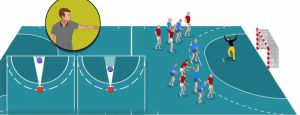
- The 7-meter throw is to be taken as a shot on goal, within 3 seconds after a whistle signal from the referee;
- The player who is taking the 7-metre throw must take up a position behind the 7-meter line;
- The ball must not be played again by the thrower or a teammate following the execution of a 7-meter throw, until it has touched an opponent or the goal;
- When a 7-meter throw is being executed, the players of the opposing team must remain outside the free throw line and at least 3 meters away from the 7-meter line;
- The 7-meter throw is to be retaken, unless a goal is scored, if the goalkeeper crosses his restraining line.
RULE 17: GENERAL INSTRUCTIONS FOR THE EXECUTION OF THE THROWS
- Prior to the execution, the thrower must be in the correct position prescribed for the throw. The ball must be in the hand of the thrower;
- During the execution, except in the case of the goalkeeper throw, the thrower must have one part of a foot in constant contact with the floor until the ball is released. The other foot may be lifted and put down repeatedly;
- The thrower must remain in the correct position until the throw has been executed.
RULE 18: THE PUNISHMENTS
- Warning (yellow card – A player should not be given more than one warning, and the players of a team should not be given more than 3 warnings in total);
- Suspension (is a punishment for heavier fouls or undisciplined. It also happens after the player has already taken a yellow card, or more than 3 totals in the team);
- Disqualification (red card – punishment for serious unsportsmanlike conduct. Follow by 2 minutes suspension).
RULE 19: THE HANDBALL REFEREES
- Two referees with equal authority shall be in charge of each game. They are assisted by a timekeeper and a scorekeeper;
- The referees monitor the conduct of the players and team officials from the moment they enter the premises until they leave;
- The referees are responsible for inspecting the playing court, the goals, and the balls before the game starts; they decide which balls will be used.
RULE 20: THE TIMEKEEPER AND THE SCOREKEEPER
In principle, the timekeeper has the main responsibility for the playing time, the timeouts, and the suspension time of suspended players.
The scorekeeper has the main responsibility for the team rosters, the score sheet, the entering of players who arrive after the game has started, and the entering of players who are not entitled to participate.
MORE HANDBALL CONTENT
- The Positions Handball Players
- Handball Passive Play
- The Handball Throw-in
- Handball Fundamentals
- Handball Systems
- Handball Court
- Handball History in the Word
HANDEBOL RULES ON VIDEO
Watch the Video Lesson Rules of Handball Channel DEF.
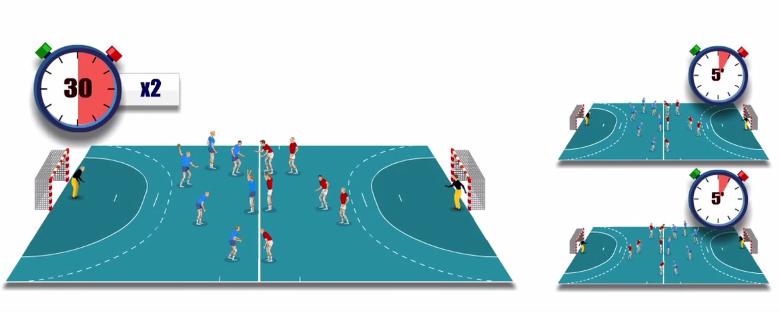
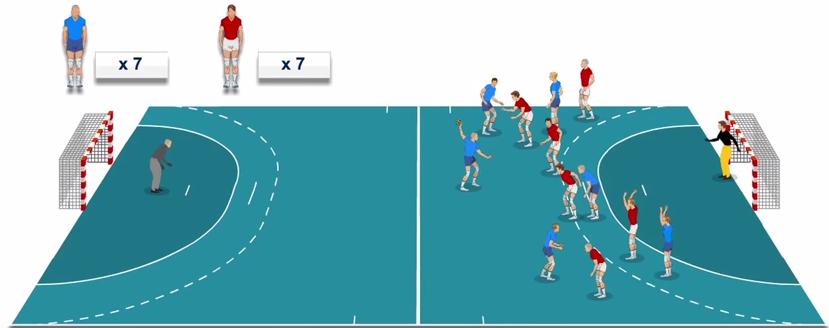
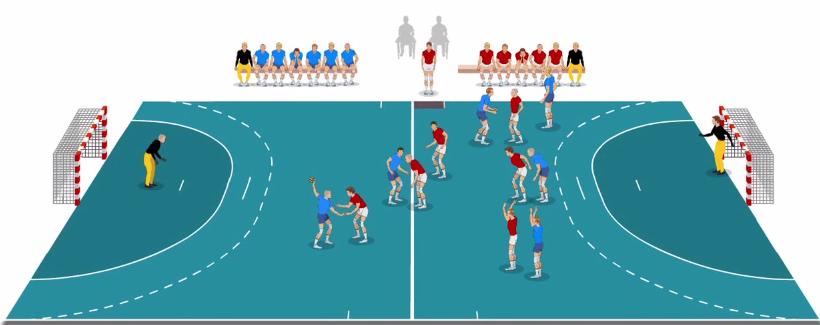
Thanks for the update